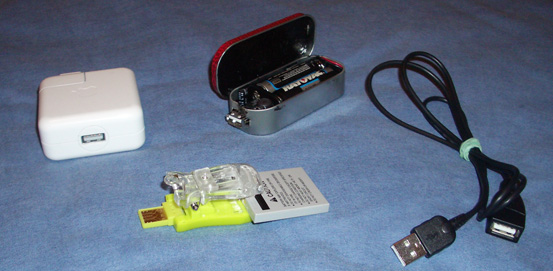When I first started writing a packlist for this trip, I knew I wanted to bring some standard bike tour/bikepacking electronics – a digital camera, helmet camera, cell phone, SPOT GPS, headlamp, cyclo-computer, and bike lights. Keeping the juice flowing to these electronics is a common hurdle on any bike trip, probably more so on the Great Divide since towns are infrequent and weight is the enemy. I have found a simple, lightweight, versatile, and inexpensive way to keep everything charged! Here are the electronic devices I’m planning to bring and how I hope to keep them alive.
Digital Camera
Let me say first off that in no way do I consider myself a photographer. Give me small and lightweight camera with a few megapixels, a little bit of zoom, and some basic setting to play around with and I’m content. My Pentax Optio S5i does the job brilliantly. Unfortunately, it only takes lithium ion batteries. These are a pain in the arse for bike tours because they usually require bulky chargers and wall outlets. For this reason, many prefer cameras that take AAs. I did not want to purchase a new camera, but I also did not want to bring a chunky charger that I could only use when connected to the grid.
Helmet Camera
One thing that inspired excitement for this trip was watching video from others’ journeys on the Divide. I’d also like to have a video account of the upcoming ride. The movie mode on my Pentax is quite bad, so I decided on a helmet/bike mounted camera – the VholdR ContourHD. Again, it only takes lithium ion batteries. Unlike my digital camera, it can be charged via USB.
Cell Phone
Nothing really interesting about my cell phone. I don’t plan to use it much, yet keeping it charged is important for the “just in case” factor (although I’ve learned not to think of it as a dependable lifeline). Plus, I have a suspicion that my mother expects me to call home every now and again. It can be charged with a wall charger or USB cable.
Headlamp, Lights, SPOT, and Cyclo-Computer
These devices are the easy ones. The headlamp and rear light take AAA batteries, the front light and SPOT use AAs (SPOT requires lithium ion AAs, though), and the cyclo-computer uses a watch battery. No chargers needed!
Keeping it all charged
Three small gadgets (and some cables) is all I need to keep the juice flowing to my devices (or any number or USB enabled devices) while in town or in the middle of nowhere.

USB is Key
On the left is the Apple USB Power Adapter that came with my iPod five years ago. It plugs into wall outlets and outputs USB spec power. This is my sole means of plugging into the grid on the trip.
The gadget in the middle-front (called a USB Emergency Battery Charger) can charge my digital camera’s batteries with USB power. It grabs the battery and makes contact with +/- leads and plugs into female USB ports. In the picture, you see it holding one of my LI batteries.
The cord on the right is a USB extension cable – it makes connecting to the chargers and/or library computers easier.
The device in the back of the picture is where the magic happens. It’s the MintyBoost v2.0. It takes two standard AA batteries and converts it to USB compatible power. Charging ALL of my devices while in the backcountry is as easy as carrying USB cables and spare AA batteries!
A Similar Alternative
I realize disposable batteries aren’t environmentally friendly by any means. Instead of the MintyBoost (or in addition to it), I could use a portable solar panel. There are many models out there that are USB compatible and lightweight – ideal for this setup. Unfortunately, though, most decent models do not fall in the inexpensive category. It is not essential that I bring one along, so in the luxury section of my shopping list it stays.
**Important notes about the MintyBoost
-It is sold as a kit and needs to be soldered. Doing so incorrectly could fry your device…so be careful.
-It provides lower amperage than computers do, meaning charge time is longer.
-I think if the batteries in the MintyBoost are dead and it is connected to a device, you may end up drawing power away from the battery you want charged.